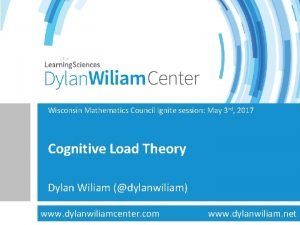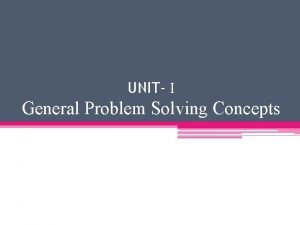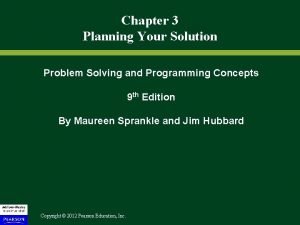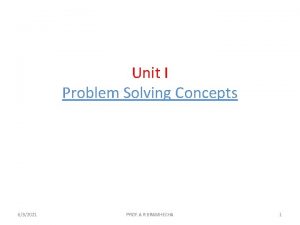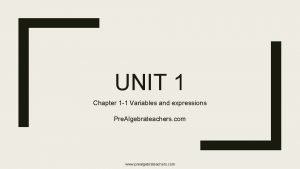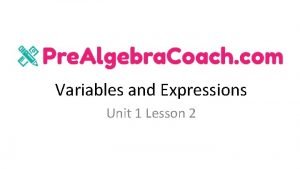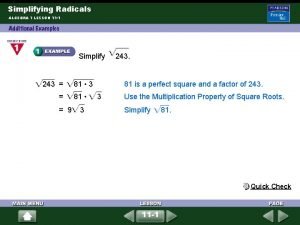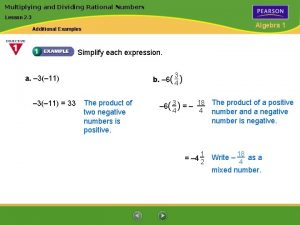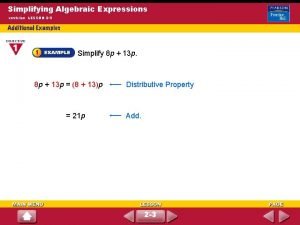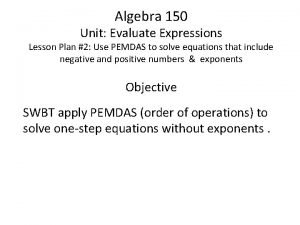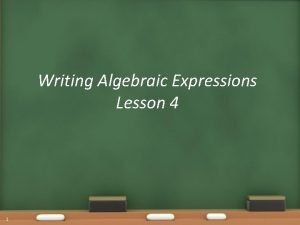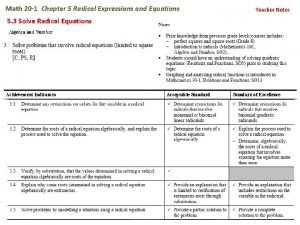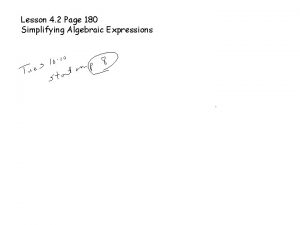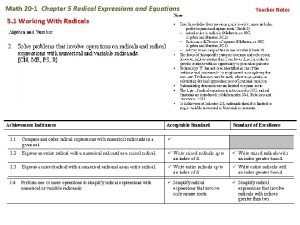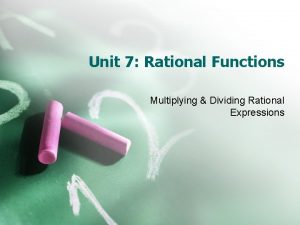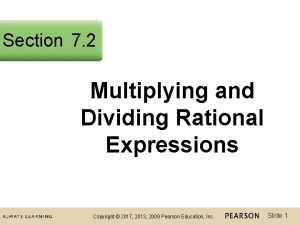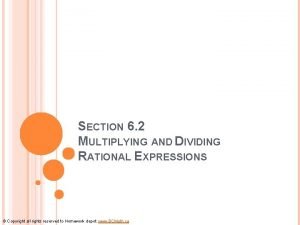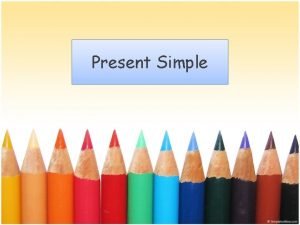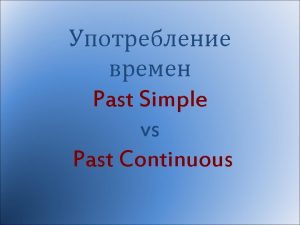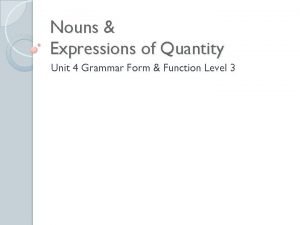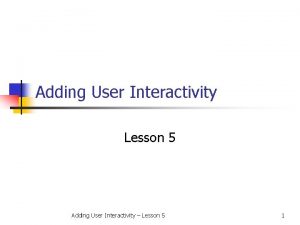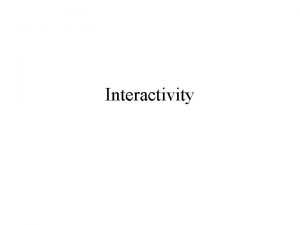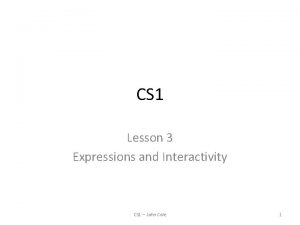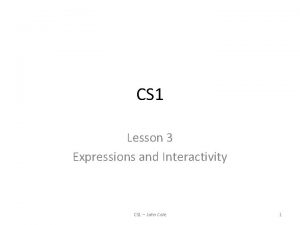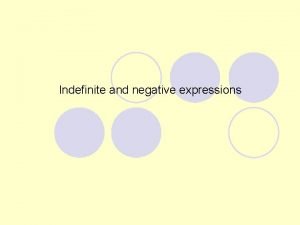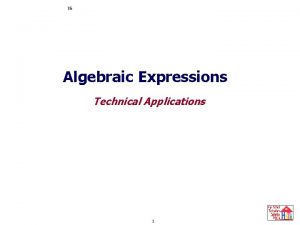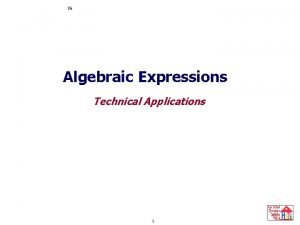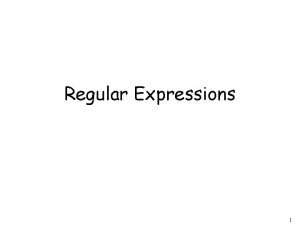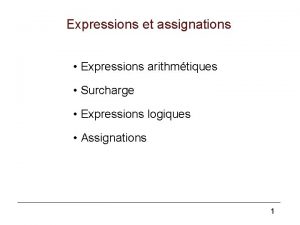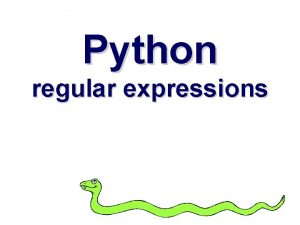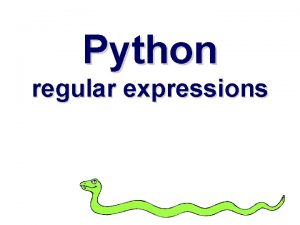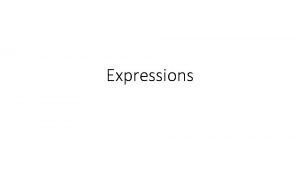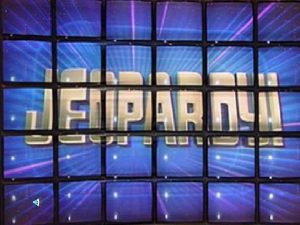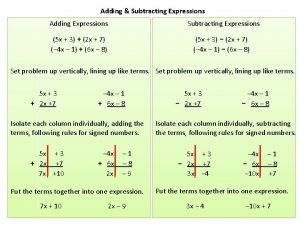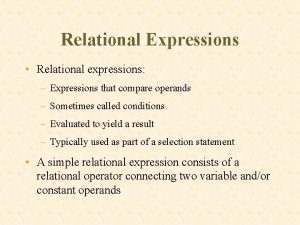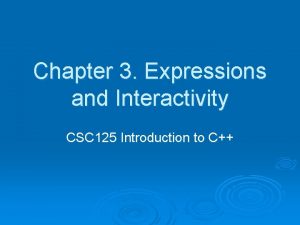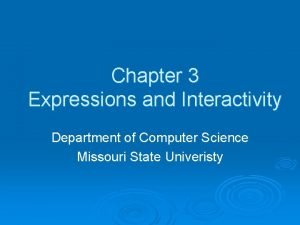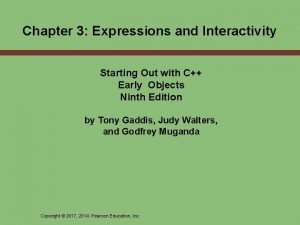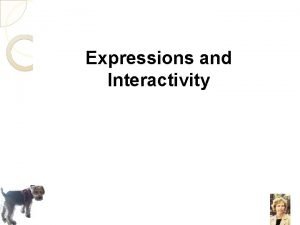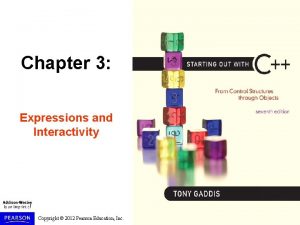CS 1 Lesson 3 Expressions and Interactivity CS


![Simple Program with cin int _tmain(int argc, _TCHAR* argv[]) { double length, width; double Simple Program with cin int _tmain(int argc, _TCHAR* argv[]) { double length, width; double](https://slidetodoc.com/presentation_image_h2/52dc77328e5f2432966653b07a56b2aa/image-3.jpg)




























- Slides: 31

CS 1 Lesson 3 Expressions and Interactivity CS 1 -- John Cole 1

The cin Object • • • Standard input object Like cout, requires iostream file Used to read input from keyboard Information retrieved from cin with >> Input is stored in one or more variables This is pronounced c-in. CS 1 -- John Cole 2
![Simple Program with cin int tmainint argc TCHAR argv double length width double Simple Program with cin int _tmain(int argc, _TCHAR* argv[]) { double length, width; double](https://slidetodoc.com/presentation_image_h2/52dc77328e5f2432966653b07a56b2aa/image-3.jpg)
Simple Program with cin int _tmain(int argc, _TCHAR* argv[]) { double length, width; double area; char ans; cout << "Program to calculate the area of a rectangle" << endl; cout << "Enter the width: "; cin >> width; cout << "Enter the length: "; cin >> length; area = length * width; cout << "The area is " << (length * width) << endl; cout << "Press a key to continue "; cin >> ans; return 0; } CS 1 -- John Cole 3

How cin Works • cin converts data you type to the data type of the variable. • Thus when you type characters for the width and length, cin converts to double if it can. • If it cannot, cin throws away characters until it finds something it can use. Your program will continue to execute and may not work right. CS 1 -- John Cole 4

More cin • Can be used to input more than one value: cin >> height >> width; • Multiple values from keyboard must be separated by spaces • Order is important: first value entered goes to first variable, etc. CS 1 -- John Cole 5

Mathematical Expressions • You can create complex expressions using multiple mathematical operators • An expression can be a literal, a variable, or a mathematical combination of constants and variables • Can be used in assignment, cout, other statements: area = 2 * PI * radius; cout << "border is: " << 2*(l+w); • In general, anywhere you can have a value, you can have an expression of the same type. CS 1 -- John Cole 6

Order of Operations In an expression with more than one operator, evaluate in this order: - (unary negation), in order, left to right * / %, in order, left to right + -, in order, left to right In the expression 2 + 2 * 2 – 2 evaluate second evaluate first CS 1 -- John Cole evaluate third 7

Associativity of Operators • - (unary negation) associates right to left • *, /, %, +, - associate right to left • parentheses ( ) can be used to override the order of operations: 2 (2 + + 2 2) * 2 – * (2 – 2 2 2) 2) = = 4 6 2 0 CS 1 -- John Cole 8

Algebraic Expressions • Multiplication requires an operator: Area=lw is written as Area = l * w; • There is no exponentiation operator: Area=s 2 is written as Area = pow(s, 2); • Parentheses may be needed to maintain order of operations: is written as m = (y 2 -y 1) /(x 2 -x 1); CS 1 -- John Cole 9

Type Conversion • Operations are performed between operands of the same type. • If not of the same type, C++ will convert one to be the type of the other (if it can. ) • This can impact the results of calculations. CS 1 -- John Cole 10

Hierarchy of Types Highest: long double float unsigned long unsigned int Lowest: int short Ranked by largest number they can hold CS 1 -- John Cole 11

Type Coercion • Type Coercion: automatic conversion of an operand to another data type • Promotion: convert to a higher type • Demotion: convert to a lower type CS 1 -- John Cole 12

Coercion Rules 1. char, short, unsigned short automatically promoted to int 2. When operating on values of different data types, the lower one is promoted to the type of the higher one. 3. When using the = operator, the type of expression on right will be converted to type of variable on left CS 1 -- John Cole 13

Overflow and Underflow • Occurs when assigning a value that is too large (overflow) or too small (underflow) to be held in a variable • Variable contains value that is ‘wrapped around’ set of possible values • Different systems may display a warning/error message, stop the program, or continue execution using the incorrect value • Thus: Check your data. CS 1 -- John Cole 14

Type Casting • Used for manual data type conversion • Useful for floating point division using ints: double m; m = static_cast<double>(y 2 -y 1) /(x 2 -x 1); • Useful to see int value of a char variable: char ch = 'C'; cout << ch << " is " << static_cast<int>(ch); CS 1 -- John Cole 15

Type Casting • Parentheses matter: • cout << "1/3 cast: " << static_cast<double>(1/3) << endl; • Is different from: • cout << "1/3 cast: " << static_cast<double>(1)/3 << endl; CS 1 -- John Cole 16

Pre-Standard Casting • C-Style cast: data type name in () cout << ch << " is " << (int)ch; • Prestandard C++ cast: value in () cout << ch << " is " << int(ch); • Both are still supported in C++, although static_cast is preferred CS 1 -- John Cole 17

Multiple Assignment and Combined Assignment • The = can be used to assign a value to multiple variables: x = y = z = 5; • Value of = is the value that is assigned • Associates right to left: x = (y = (z = 5)); value is 5 CS 1 -- John Cole 18

Combined Assignment • Adding value to a variable and putting the result back in the variable is a very common operation. • On many computers, this is a single instruction. CS 1 -- John Cole 19

Combined Assignment CS 1 -- John Cole 20

Formatting Output • Can control how output displays for numeric, string data: – size – position – number of digits • Requires iomanip header file • Some affect just the next value displayed: CS 1 -- John Cole 21

Stream Manipulators CS 1 -- John Cole 22

Set Width • setw(x): print in a field at least x spaces wide. Use more spaces if field is not wide enough CS 1 -- John Cole 23

Control Decimal Points • These affect values until changed again: – fixed: use decimal notation for floating-point values – setprecision(x): when used with fixed, print floating-point value using x digits after the decimal. Without fixed, print floating-point value using x significant digits – showpoint: always print decimal for floatingpoint values CS 1 -- John Cole 24

Characters and Strings • Using cin with the >> operator to input strings can cause problems: • It passes over and ignores any leading whitespace characters (spaces, tabs, or line breaks) • To work around this problem, you can use a C++ function named getline. CS 1 -- John Cole 25

Inputting Characters and Strings • Mixing cin >> and cin. get() in the same program can cause input errors that are hard to detect • To skip over unneeded characters that are still in the keyboard buffer, use cin. ignore(): cin. ignore(); // skip next char cin. ignore(10, 'n'); // skip the next // 10 char. or until a 'n' CS 1 -- John Cole 26

string Member Functions and Operators • To find the length of a string: string state = "Texas"; int size = state. length(); • To concatenate (join) multiple strings: greeting 2 = greeting 1 + name 1; greeting 1 = greeting 1 + name 2; Or using the += combined assignment operator: greeting 1 += name 2; CS 1 -- John Cole 27

More string Operations • http: //www. learncpp. com/cpp-tutorial/17 -1 stdstring-and-stdwstring/ CS 1 -- John Cole 28

Math Functions • Require cmath header file • Take double as input, return a double • Commonly used functions: sin Sine function cos Cosine function tan Tangent sqrt Square root log Natural log (base e) abs Absolute value (takes an int and returns an int) pow Raise a number to a power (exponentiation) CS 1 -- John Cole 29

More Math Functions • These require cstdlib header file • rand(): returns a random number (int) between 0 and the largest int the compute holds. Yields same sequence of numbers each time program is run. • srand(x): initializes random number generator with unsigned int x CS 1 -- John Cole 30

Hand Tracing a Program • Trace the execution of the Fibonacci program. CS 1 -- John Cole 31
 Element interactivity
Element interactivity Digital interactivity
Digital interactivity Difficulties in problem solving
Difficulties in problem solving Problem analysis chart programming
Problem analysis chart programming Problem analysis chart
Problem analysis chart Ipo chart
Ipo chart Interactivity
Interactivity 1-1 variables and expressions
1-1 variables and expressions What is a numerical expression
What is a numerical expression Practice 11-1 simplifying radical answers
Practice 11-1 simplifying radical answers Algebra 1 examples
Algebra 1 examples Unit 7 lesson 2 simplify expressions
Unit 7 lesson 2 simplify expressions Order of operations lesson plan
Order of operations lesson plan Algebra write expressions lesson 4
Algebra write expressions lesson 4 What is radical 20
What is radical 20 Simplify each expression.
Simplify each expression. Radicals math
Radicals math Micro teach lesson plan
Micro teach lesson plan Sat vocabulary lesson 4
Sat vocabulary lesson 4 Lesson outline lesson 1 solids liquids and gases answer key
Lesson outline lesson 1 solids liquids and gases answer key Lesson 4 gravity and motion lesson review
Lesson 4 gravity and motion lesson review Magnets and magnetic fields lesson 1 answer key
Magnets and magnetic fields lesson 1 answer key Lesson outline lesson 3 eclipses and tides answer key
Lesson outline lesson 3 eclipses and tides answer key Writing and evaluating expressions
Writing and evaluating expressions Rational expressions and functions
Rational expressions and functions Symbols and expressions.
Symbols and expressions. 11-4 practice multiplying and dividing rational expressions
11-4 practice multiplying and dividing rational expressions 11-4 multiplying and dividing rational expressions
11-4 multiplying and dividing rational expressions Simple present tense always usually often
Simple present tense always usually often Time expression
Time expression Expression of quantity
Expression of quantity Multiplying and dividing rational expressions quizlet
Multiplying and dividing rational expressions quizlet
